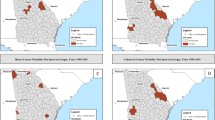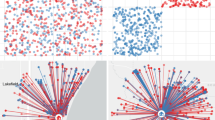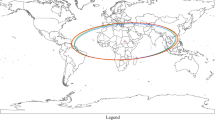Abstract
The possibilities of clustering between those electoral wards which display higher than expected incidences of cases of the lymphomas occurring between 1978 and 1982 are examined. Clusters are defined as being those wards with cases in excess (at a probability of less than 10%) which are geographically adjacent to each other. A separate analysis extends the definition of cluster to include high incidence wards that are adjacent or separated by one other ward. The results indicate that many high incidence lymphoma wards do occur close together and when computer simulations are used to compute expected results, many of the observed results are shown to be highly improbable both in the overall number of clustering wards and in the largest number of wards comprising a 'cluster'.
This is a preview of subscription content, access via your institution
Access options
Subscribe to this journal
Receive 24 print issues and online access
$259.00 per year
only $10.79 per issue
Buy this article
- Purchase on Springer Link
- Instant access to full article PDF
Prices may be subject to local taxes which are calculated during checkout
Similar content being viewed by others
Author information
Authors and Affiliations
Rights and permissions
About this article
Cite this article
Barnes, N., Cartwright, R., O'Brien, C. et al. Spatial patterns in electoral wards with high lymphoma incidence in Yorkshire health region. Br J Cancer 56, 169–172 (1987). https://doi.org/10.1038/bjc.1987.179
Issue Date:
DOI: https://doi.org/10.1038/bjc.1987.179



